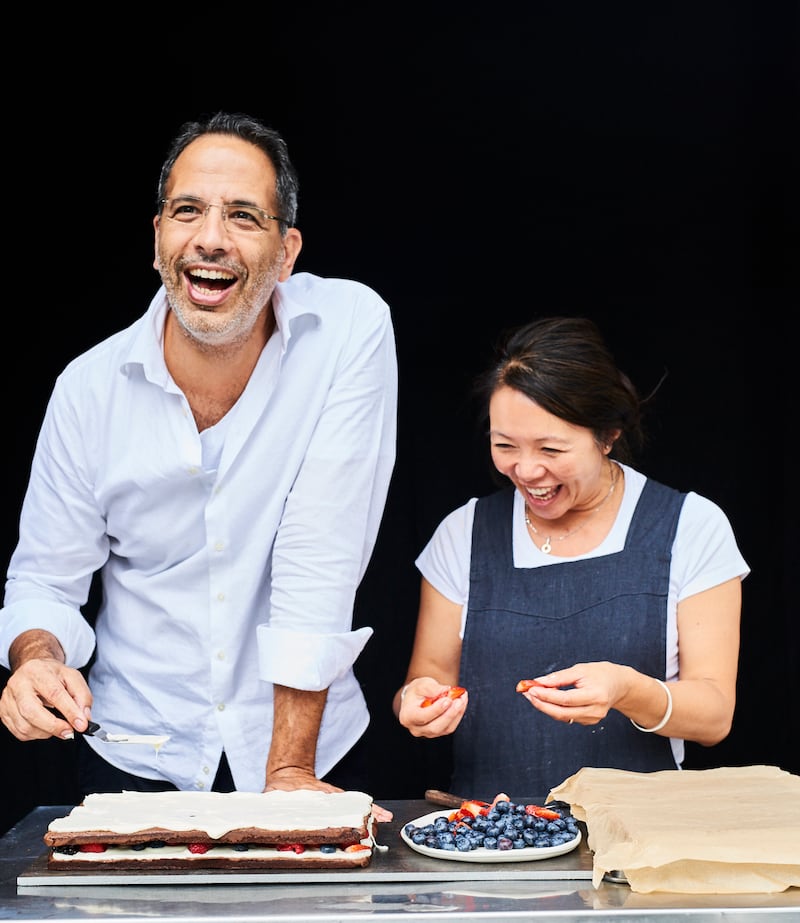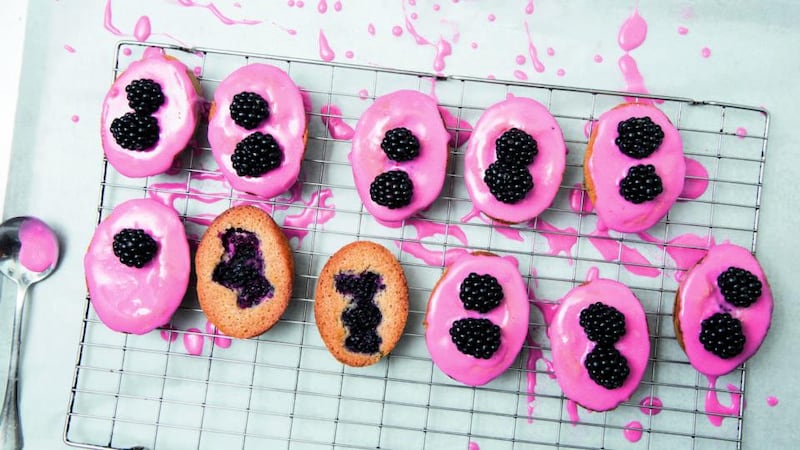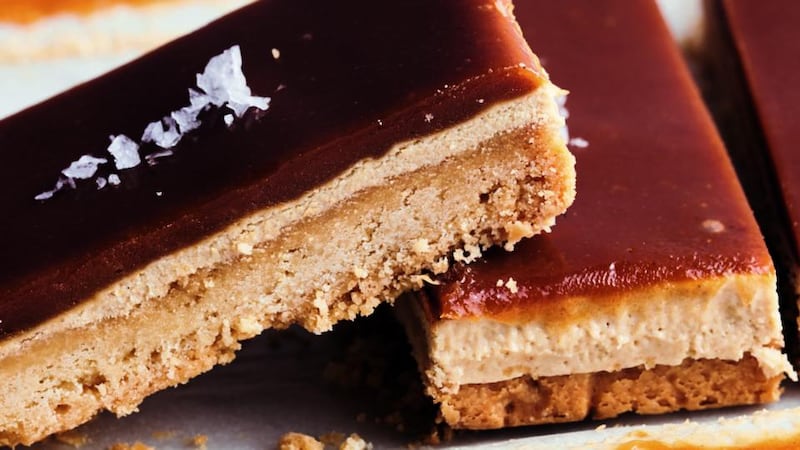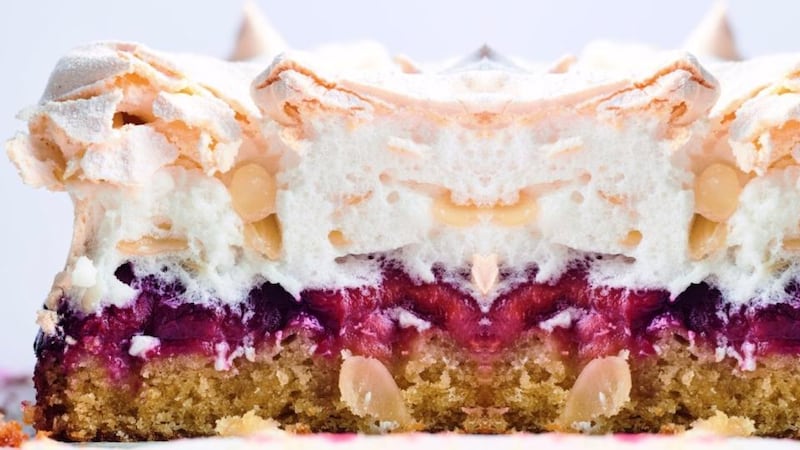If you listen carefully to Yotam Ottolenghi you might detect a slight change to his distinctive voice. A very faint but discernible Irish lilt has crept into some words the Israeli-born London chef and food writer uses.
"My husband is from Northern Ireland, and this summer we've spent a lot of time with his family. His family are from south Down, but we have relocated for the summer to north Down. They're there most of the time, and I'm coming and going," he says, referring to Karl Allen and the couple's two sons, four-year-old Max and two-year-old Flynn. They've been based near Donaghadee, and "driving a lot around along the coast".
“It’s really so beautiful, so we’ve been spending quite a lot of time there. I love it. I prefer the weather in Ireland to London, because in Ireland you get many more sunny patches in the week. Here you get a lot of these continuously grey days. In Ireland it was a bit cooler, but we had a lot of sunny spells.”
He will be back in Ireland next week, in Dublin this time, for a sold-out event at the Pavilion Theatre in Dún Laoghaire on Tuesday night at which he and his coauthor Helen Goh will talk about their new book, Sweet.
Given that the Ottolenghi delis in London are famous for their billowy meringues and artfully displayed cakes, Sweet has been an eagerly awaited work
It is a collection of more than 100 recipes for cakes, biscuits, tarts, desserts and confectionery, and given that the Ottolenghi delis in London are famous for their billowy meringues and artfully displayed cakes, it has been an eagerly awaited work.
Drinking green tea in the York & Albany, a Gordon Ramsay gastropub and hotel in the London neighbourhood of Camden, where he lives and where his test kitchen is located, Ottolenghi introduces me to his latest collaborator.
Goh was born in Malaysia but raised in Australia, where she lived until coming to London, and where she ran Mortar & Pestle, a cafe known for its delicious cakes and pastries, in a suburb of Melbourne.
She is a doctor of psychology as well as a pastry chef – her dissertation was on women’s reproductive choices – and she maintains a small private practice, as well as being head of product development at Ottolenghi.
Which strand of her diverse career does she prefer, I ask, and she whispers “cooking”, before explaining that she keeps her psychology practice open so she can be available to patients of long standing. She has two children, aged two and six, and has lived in London since 2006.
Goh has worked at Ottolenghi since arriving in the city. “I got a little tip-off,” the company namesake says. “This friend of a friend is coming from Australia, and she’s going to introduce herself to you. You should really grab her, because she’s really good.”
Her cake prowess soon came to the fore, and Goh was the obvious choice to cowrite the first Ottolenghi book dedicated entirely to sweet things. The pair are close friends. When I ask if they have a sweet tooth they chorus “absolutely”, with a laugh, and admit that they had been baking cookies in Goh’s house earlier, but there were none to share as they’d eaten them all.
There is something about the balancing of the sweet and the savoury that is so strongly rooted in our culture that I really wouldn't want to lose the sweet
“No meal is complete without a little something sweet at the end,” Ottolenghi says when asked if he has a preference for savoury or sweet. “There is something about the balancing of the sweet and the savoury that is so strongly rooted in our culture that I really wouldn’t want to lose the sweet.”
Goh says she could give up eating cake, “but I’d be so unhappy I’d be unbearable to live with”. In any case, with more than 100 recipes to create and test in the meticulous Ottolenghi way, giving up sweet treats – and the sugar they contain – wasn’t an option for the pair during the book’s two-year gestation.

They seem primed for questions about the advisability or otherwise of consuming sugar, now that it has replaced fat as a major cause for concern in some dietary circles, and they tackle the topic head on in a preface to the book entitled “Our sugar manifesto”. This espouses transparency, and the ability of readers to make their own informed decisions.
“It’s hard to ignore the fact that we’re operating in a world where sugar is debated. For us it’s a neutral subject, really. Both Helen and I have had sugar on our benchtops forever,” Ottolenghi says. “What we tried to put across is that there’s nothing wrong with a bit of sugar, there’s nothing wrong with baking a cake, and there’s everything wrong with consuming things that you haven’t made and you don’t know what’s in them.”
For Goh it’s about moderation. “When I think of cake what I conjure up is conviviality, sharing, conversation. If you’re surreptitiously eating a slab of cake on your own, well, that’s maybe not healthy, but in the context of celebration or sharing that’s absolutely one of life’s greatest joys.”
With every new Ottolenghi book comes a new ingredient that will move from specialist to mainstream. You’ll find sumac, zaatar and pomegranate molasses stocked in supermarkets now, thanks to what is know as the Ottolenghi effect. With Sweet we can expect a flurry of interest in Dutch-processed cocoa powder. “It’s to do with the process, which they call Dutching, of removing some of the acid, which means that your bakes are a little bit more balanced, more even,” Goh explains.
Asked to pick a standout recipe from the book, Ottolenghi and his coauthor, Helen Goh, agree on Frozen Espresso Parfait for a Crowd
You might also need to visit the chemist to stock up on 1500mg vitamin C tablets, which make an intriguing appearance in the ingredients for beetroot, ginger and soured cream cake.
"When I was working at Baker & Spice years ago we used to poach a lot of quinces, and a French chef said if you put vitamin C in the boiling juices you'd get a nicer colour," Ottolenghi explains.
“Then, when Helen was testing the beetroot cake, it had a beautiful colour before it was baked, but when it came out of the oven all that redness had disappeared, so I suggested we should grind some vitamin C into the cake mix – and it really helped.”
Asked to pick a standout recipe from the book, they agree on Frozen Espresso Parfait for a Crowd, a coffee ice-cream, hazelnut and chocolate meringue and coffee praline dessert, the ingredients and method for which run to three pages.
“It’s really exceptional, but it’s much more of an effort than any other recipe in the book,” Ottolenghi says. “The beautiful thing about this one is that we’ve had it months after we’ve tested it. There was a big slab lying in the freezer, and every week someone would take it out and have a piece and say how delicious it was.”
We're working on recipes that are simpler, a little bit more for daily cooking, a little bit like less occasion driven
If this show-stopper majors on a long list of ingredients and a complicated method, Ottolenghi’s next book is its antithesis. It’s provisionally called Simple. “We’re working on recipes that are simpler, a little bit more for daily cooking, a little bit like less occasion driven. There are quite a few recipes with eight, nine or 10 ingredients, which is unheard of in the Ottolenghi world,” he says. “We’re trying to tackle it from different directions. The idea is to be quite clever about it and see what does simple mean to different people.”
The structure of the book follows different interpretations of simple. “We’ve got less than 10 ingredients, we’ve got cupboard ingredients, we’ve got 30 minutes . . .”
“I thought you said less than 30 ingredients,” Goh says, and they both burst out laughing. “Oh, that would be a challenge!” says the master of many ingredients.
- Sweet, by Yotam Ottolenghi and Helen Goh, with photography by Peden + Munk, is published by Ebury Press
Yotam Ottolenghi and Helen Goh’s blackberry and star anise friands

These look splendid when iced – destined for top ranking on any tiered cake stand – but also work uniced, in the cookie tin, for grabbing on a whim. They'll lose their slightly chewy edge after the first day or so but still taste great. Blueberries or raspberries can be used instead of the blackberries. Don't use strawberries, though: they are too watery.
Preheat the oven to 220 degrees/200 degrees fan/gas mark 7.
Brush the 12 holes of a regular muffin tin with the melted butter and sprinkle all over with flour. Tap the tray gently to ensure an even coating of the flour, then turn upside down to remove the excess. Place in the fridge to chill while you make the batter.
To brown the butter, place in a small saucepan and cook over a medium heat until melted. Continue to cook until the butter is foaming, gently swirling the pan from time to time, to allow the solids to brown more evenly. You will see dark-brown sediments begin to form on the sides and bottom of the pan. Continue to allow the butter to bubble away until it turns a rich golden brown and smells of toasted nuts and caramel. Remove the pan from the heat and let it stand for 5 minutes, to allow the burnt solids to collect at the bottom of the pan. Strain through a fine-mesh (or muslin- lined) sieve, discarding the solids. Allow the browned butter to cool slightly before using. It should still be warm when folding into the mix later: if it is too hot it will start to cook the egg whites; if it is too cool it will be difficult to incorporate into the mix.
While the butter is cooling, sift the flour, icing sugar, ground almonds, star anise and salt into a bowl. Put the egg whites in a small bowl and use a whisk or fork to froth them up for a few seconds – you do not need to whisk them completely. Pour the egg whites into the sifted dry ingredients and stir until they are incorporated. Add the orange zest and browned butter and mix until the batter is smooth.
Remove the muffin tin from the fridge and fill the moulds just over two-thirds of the way up the sides. Place three halved blackberries on top, cut side down, and bake for 10 minutes. Reduce the temperature to 210 degrees/190 degrees fan/gas mark 6 – starting with a high oven temperature and then bringing it down is the way to achieve the lovely brown crust you want – turn the tray around in the oven for even cooking, and continue to cook for another 8 minutes, until the edges of the friands are golden brown and the centres have a slight peak and spring back when gently prodded. Set aside to cool before removing them from their moulds; you might need to use a small knife to help you release the sides.
If you are icing the cakes, put 60g of blackberries in a small bowl with the water and lemon juice. Use a fork to mash them together, then pass the mixture through a fine-mesh sieve to extract as much fruit juice as possible: you should get about 60ml. Sift the icing sugar into a medium bowl, pour in the blackberry juice and combine to make a light-purple runny icing: it should just be thick enough to form a thin glaze on the tops of the cakes.
Spoon the icing over the cakes, spreading it to the edges so that it runs down the sides. Do this on a rack, if you can, as icing them on a plate or sheet of paper means that the icing will pool at the bottom. Put 2 small blackberries on each friand, set aside for 20 or 30 minutes to set, then serve.
Yotam Ottolenghi and Helen Goh's Middle Eastern millionaire’s shortbread

A three-layer bar with a shortbread bottom, halva in the middle and a glossy tahini caramel on top. This was a winning combination just waiting to happen. And happen it did, thanks to Paulina Bembel, our head pastry chef. Paulina, who comes from Poland, uses our Middle Eastern favourites – tahini and halva – to transform the famously cloying millionaire’s shortbread into something so much better, with a slight bitterness and a touch of salt to offset all that sweetness.
Preheat the oven to 200 degrees/180 degrees fan/gas mark 6.
Line a 20cm square tin with baking parchment, making sure that the paper rises up over the edges of the tin.
For the shortbread, sift the icing sugar and cornflour into the bowl of an electric mixer with the paddle attachment in place, then add the caster sugar and mix on a medium speed. With the machine still running, slowly pour in the melted-but-cooled butter and beat until combined. Add the vanilla and reduce the speed to low, then sift in the flour and salt and continue to beat until the dough comes together.
Tip the mixture into the tin and use your hands to pat and even out the surface. Bake for 25 minutes or until golden brown. Remove from the oven and set aside until completely cool. This will take an hour or so, so don’t start making the caramel too soon or it will have set by the time the shortbread is cool.
For the halva layer, put the halva and tahini in a small bowl and mix with a wooden spoon to combine. Spread the mix over the cooled shortbread and use the back of a spoon to smooth it out to an even layer.
To make the caramel, place the sugar and water in a small saucepan and put over a medium-low heat. Stir occasionally, until the sugar has dissolved, then increase the heat to medium-high. Bring to a boil and cook, still at a boil, for about 12 minutes, until the sugar is a deep golden brown. Remove from the heat and add the butter and cream: take care here, as the mixture will splutter. Whisk to combine, and, once the butter has melted, add the tahini and salt. Whisk to combine again, then pour evenly over the halva layer in the tin, so that all of the halva is covered.
Refrigerate for at least 4 hours, until set, before cutting into bars, about 10cm by 2.5cm. Sprinkle a pinch of sea salt over the middle of each bar and serve.
Yotam Ottolenghi and Helen Goh’s Louise cake with plum and coconut

This is inspired by – but completely different from! – the “Louise” cake, a hugely popular teatime treat in New Zealand. More of a slice than a cake, it’s traditionally made with a thin cakey bottom, a spread of raspberry jam in the middle and a thin layer of coconut meringue on top. We’ve kept the layers theme but rung a lot of changes.
We sell this in our shops as a “summer slice”, using the best stone fruits, from peaches to apricots to cherries, depending on what’s in season. Whichever fruit you use, it needs to be ripe but not too soft.
Preheat the oven to 170 degrees/150 degrees fan/gas mark 3.
Spread the flaked almonds for the meringue on a baking tray and roast for 10 minutes, until they are a light golden brown. Remove from the oven and set aside to cool.
Turn up the oven to 185 degrees/165 degrees fan/gas mark 5. Line the base and sides of a high-sided 20cm square or 23cm round tin (with a removable base) with baking parchment.
Put the butter, sugar and lemon zest in the bowl of an electric mixer with the paddle attachment in place. Beat on a medium-high speed, until light and creamy. Add the egg yolks, one at a time, and beat until combined. Sift the flour, baking powder and salt together into a bowl. Add the coconut and stir to combine.
With the machine on a low speed, gradually add the dry ingredients to the butter mix, alternating with the milk and vanilla.
Scrape the batter into the prepared tin – it will rise only about a fifth of the way up the sides – and smooth the top evenly. Place in the oven and cook for 25 minutes, until the cake is fully cooked and a skewer inserted into the centre comes out clean.
Meanwhile, prepare the plums. Slice each plum vertically in half. Discard the stones and slice each half into four segments, so that you have eight segments per plum and 40 segments in total. If you start with a larger quantity of smaller plums, or a smaller stone fruit, like cherries, then just quarter each fruit.
When the cake is cooked, remove it from the oven and turn the temperature up to 200 degrees/180 degrees fan/gas mark 6. Gently lay the plum segments on top of the cake, close together and cut side down. Don’t overlap the fruit, though, as this will make the middle layer too watery.
To make the meringue, place the egg whites and salt in the clean bowl of an electric mixer with the whisk attachment in place. Beat on a medium-high speed for about 1 minute, until soft peaks form. Add the sugar, a tablespoon at a time, and continue to whisk on a high speed until the egg whites are stiff and glossy. Add the vanilla, vinegar and cornflour and whisk again, until combined. Finally, fold in the toasted flaked almonds.
Scrape the meringue into the cake tin, on top of the plums, and spread out evenly over the fruit. Swirl the meringue around, so you get rough waves and peaks, then put in the oven. Immediately lower the temperature to 180 degrees/160 degrees fan/gas mark 4 and bake for 35 minutes, or until the meringue has formed a hard crust and is just beginning to brown.
Remove from the oven and allow to cool in the cake tin for at least 30 minutes before pushing up the removable base to release the cake. Peel away the parchment paper, place on a platter, and serve.
Recipes from Sweet by Yotam Ottolenghi and Helen Goh (Ebury Press). Photograph: Peden + Munk










